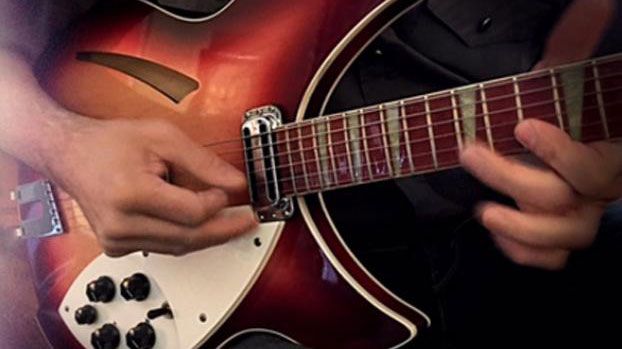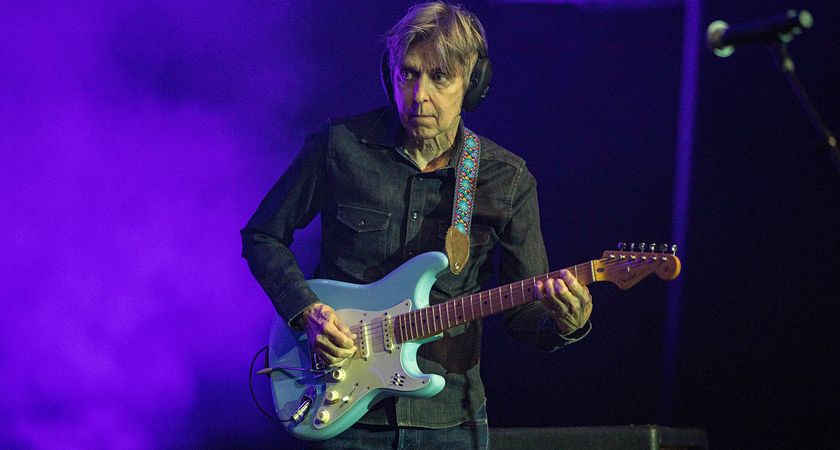One Quick Trick to Solo Over 7b9 Chords
Learn how you can use harmonic arpeggios to build interesting lines when using a 7b9 diminished scale in your soloing ideas.

One of the questions I get asked the most is, “How can I spice up my diminished-scale soloing ideas beyond just playing the scale or the arpeggio?”
To help answer this question, in this lesson we’ll be looking into one of my favorite ways to expand your 7b9 diminished soloing ideas using various arpeggios built from the underlying harmony of the scale.
By looking into the four dim7 and four 7th chords that are built from this scale, you can quickly expand your 7b9 diminished soloing ideas without having to study anything beyond these two common arpeggio shapes.
Let’s dig in and check out how you can use harmonic arpeggios to build interesting lines when using a 7b9 diminished scale in your soloing ideas.
What is the 7b9 Diminished Scale?
To begin, let’s take a quick look at the 7b9 diminished scale, otherwise known as the half whole diminished scale, before moving on to looking at the harmony built from the notes in this scale.
This eight-note scale has the following interval pattern:
Root-m2-m3-M3-D5-P5-6-b7
You can think of some of these notes as several intervals depending on how you see the fretboard, such as seeing the M3 as a D4, or the D5 as an A4, but I find that the above intervals are the easiest way for me to visualize them quickly on the fretboard.
This scale, as the name suggests, is used to solo over a 7b9 chords, and you can see a sample two-octave fingering for this scale over an A7b9 chord below.

If this scale is new to you, try working it in 12 keys across the fretboard, as well as finding at least two or three fingerings you can use to play this scale in different parts of the fretboard, such as sixth-, fifth- and fourth-string root fingerings.
7b9 Diminished Scale Harmony
One of the coolest musical concepts that comes from the 7b9 diminished scale, again otherwise known as the half-whole diminished scale, is the arpeggio patterns that are derived from this scale.
Along with the four dim7 chords that come from this scale, from the b9, 3, 5 and b7 of the underlying chord, you can also derive four 7th chords from the same scale, built from the root, b3, b5 and dim7 of the scale.
When applied to an A7b9 chord, you can build four dim7 and four 7th chords from the underlying diminished scale that you can then use to solo over this chord type in your jazz guitar improvisations.
- 7ths – A7, C7, Eb7, Gb7
- dim7 – Bbdim7, Dbdim7, Edim7, Gdim7
You can see these arpeggios with a sample fingering below that you can use as a starting point when taking these arpeggios to your jazz guitar practice routine.

When you have worked out this arpeggio pattern over A7b9, make sure to practice it in other positions on the fretboard for this chord, as well as apply this concept to all 12 keys of 7b9 chords around the fretboard as you expand upon these arps in the woodshed.
As well, try putting on a 7b9 backing track and play these arpeggios, one at a time or several combined at once, over this track in order to hear how they sound when applied to a harmonic situation.
7b9 Diminished Scale Lick
To help you take this idea to a musical situation in your practicing, here is a sample lick that uses the arpeggios from the previous section to outline the V7b9 chord in a ii V I progression in the key of D minor.
Once you have memorized this lick in the key of D minor, practice running it through all 12 keys at different tempos around the fretboard, as well as apply it to tunes that you are shedding in your practice routine.

When this lick is comfortable in your playing, try writing out three to five similar licks of your own that use the concepts from this lesson to create those jazz guitar 7b9 phrases.
Practicing 7b9 Diminished Scale Harmony
Once you have checked out the arpeggios and lick in the above lesson, you can move forward with this material in your own jazz guitar practice routine. Here are five exercises you can do to expand upon these ideas.
01. Put on an A7b9 backing track and solo over that chord using the A7 half-whole diminished scale as the basis for your lines.
02. Solo over the same A7b9 backing track using only the four 7th chords from the HW dim scale to build your lines, A7-C7-Eb7-Gb7.
03. Solo over the same A7b9 backing track using only the four dim7 chords from the HW dim scale to build your lines, Bbdim7-Dbdim7-Edim7-Gdim7.
04. Repeat exercises 1 to 3 over all 12 keys for 7b9 chords.
05. Put on a tune such as "Tune Up" by Miles Davis and treat every 7th chord as a 7b9 chord in order to use the scale and arps from this lesson to build your lines over those changes.
From there, try taking this diminished scale harmony material to other tunes that you know or are working on in the woodshed as you take these concepts further in the practice room.
Do you have a question about 7b9 diminished scale harmony? Share your thoughts in the comments section below.
Matt Warnock is the owner of mattwarnockguitar.com, a free website that provides hundreds of lessons and resources designed to help guitarists of all experience levels meet their practice and performance goals. Matt lives in the UK, where he is a lecturer in Popular Music Performance at the University of Chester and an examiner for the London College of Music (Registry of Guitar Tutors).
Get The Pick Newsletter
All the latest guitar news, interviews, lessons, reviews, deals and more, direct to your inbox!
Matt Warnock is the owner of mattwarnockguitar.com, a free website that provides hundreds of lessons and resources designed to help guitarists of all experience levels meet their practice and performance goals. Matt lives in the UK, where he teaches Skype guitar students all over the world, and is an examiner for the London College of Music (Registry of Guitar Tutors).






![Joe Bonamassa [left] wears a deep blue suit and polka-dotted shirt and plays his green refin Strat; the late Irish blues legend Rory Gallagher [right] screams and inflicts some punishment on his heavily worn number one Stratocaster.](https://cdn.mos.cms.futurecdn.net/cw28h7UBcTVfTLs7p7eiLe-840-80.jpg)






